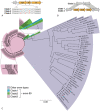Genetic Characterization of Streptococcus pyogenes emm 89 Strains Isolated in Japan From 2011 to 2019
- PMID: 38630060
- PMCID: PMC7769053
- DOI: 10.1097/IM9.0000000000000038
Genetic Characterization of Streptococcus pyogenes emm 89 Strains Isolated in Japan From 2011 to 2019
Abstract
Invasive infection caused by Streptococcus pyogenes emm89 strains has been increasing in several countries linked to a recently emergent clade of emm89 strains, designated clade 3. In Japan, the features of emm89 S. pyogenes strains, such as clade classification, remains unknown. In this study, we collected emm89 strains isolated from both streptococcal toxic shock syndrome (STSS) (89 STSS isolates) and noninvasive infections (72 non-STSS isolates) in Japan from 2011 to 2019, and conducted whole-genome sequencing and comparative analysis, which resulted in classification of a large majority into clade 3 regardless of disease severity. In addition, invasive disease-associated factors were found among emm89 strains, including mutations of control of virulence sensor, and absence of the hylP1 gene encoding hyaluronidase. These findings provide new insights into genetic features of emm89 strains.
Keywords: Streptococcus pyogenes; clade 3; emm89; streptococcal toxic shock syndrome.
Copyright © 2020 the Author(s). Published by Wolters Kluwer Health, Inc.
Conflict of interest statement
Conflicts of Interest: The authors reported no conflict of interest.
Figures



Similar articles
-
Outbreak of Streptococcus pyogenes emm89 ST646 in a head and neck surgical oncology ward.Microbiol Spectr. 2024 May 2;12(5):e0426023. doi: 10.1128/spectrum.04260-23. Epub 2024 Apr 8. Microbiol Spectr. 2024. PMID: 38587390 Free PMC article.
-
Trading Capsule for Increased Cytotoxin Production: Contribution to Virulence of a Newly Emerged Clade of emm89 Streptococcus pyogenes.mBio. 2015 Oct 6;6(5):e01378-15. doi: 10.1128/mBio.01378-15. mBio. 2015. PMID: 26443457 Free PMC article.
-
Genome sequence analysis of emm89 Streptococcus pyogenes strains causing infections in Scotland, 2010-2016.J Med Microbiol. 2017 Dec;66(12):1765-1773. doi: 10.1099/jmm.0.000622. Epub 2017 Nov 3. J Med Microbiol. 2017. PMID: 29099690 Free PMC article.
-
Invasive Streptococcus agalactiae (group B streptococcus) infection with toxic shock-like syndrome: A report of a fatal non-pregnant case and a review of the literature.J Infect Chemother. 2024 Jan;30(1):71-76. doi: 10.1016/j.jiac.2023.09.003. Epub 2023 Sep 14. J Infect Chemother. 2024. PMID: 37716644 Review.
-
Severe group A streptococcal infection and streptococcal toxic shock syndrome.Can J Anaesth. 2000 Nov;47(11):1129-40. doi: 10.1007/BF03027968. Can J Anaesth. 2000. PMID: 11097546 Review.
Cited by
-
Identifying genetic variations in emm89 Streptococcus pyogenes associated with severe invasive infections.Elife. 2025 Jul 24;14:RP101938. doi: 10.7554/eLife.101938. Elife. 2025. PMID: 40704999 Free PMC article.
-
A comprehensive analysis of antimicrobial resistance of clinical emm89 Streptococcus pyogenes in Japan.JAC Antimicrob Resist. 2025 Feb 19;7(1):dlaf017. doi: 10.1093/jacamr/dlaf017. eCollection 2025 Feb. JAC Antimicrob Resist. 2025. PMID: 39973909 Free PMC article.
-
Outbreak of Streptococcus pyogenes emm89 ST646 in a head and neck surgical oncology ward.Microbiol Spectr. 2024 May 2;12(5):e0426023. doi: 10.1128/spectrum.04260-23. Epub 2024 Apr 8. Microbiol Spectr. 2024. PMID: 38587390 Free PMC article.
-
The Anti-Biofilm Potential of Linalool, a Major Compound from Hedychium larsenii, against Streptococcus pyogenes and Its Toxicity Assessment in Danio rerio.Antibiotics (Basel). 2023 Mar 9;12(3):545. doi: 10.3390/antibiotics12030545. Antibiotics (Basel). 2023. PMID: 36978412 Free PMC article.
References
-
- Sims Sanyahumbi A, Colquhoun S, Wyber R, Carapetis JR. Global disease burden of group A Streptococcus. In: Ferretti JJ, Stevens DL, Fischetti VA, eds. Streptococcus pyogenes: Basic Biology to Clinical Manifestations. Oklahoma City (OK): University of Oklahoma Health Sciences Center; 2016. - PubMed
-
- Henningham A, Barnett TC, Maamary PG, Walker MJ. Pathogenesis of group A streptococcal infections. Discov Med 2012;13(72):329–342. - PubMed
Grants and funding
LinkOut - more resources
Full Text Sources
